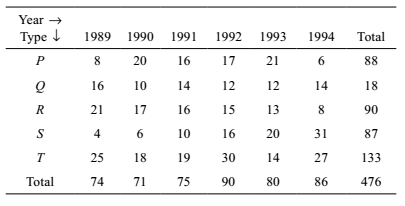Table chart
Direction: Directions: Study the following Tables carefully and answer the questions given below.

- The total number of blue-coloured cars of Model E and D sold in Metro H is exactly equal to the number of white-coloured cars of which model in Metro M?
-
View Hint View Answer Discuss in Forum
Blue (E + D) = 37 + 43 = 80 = White (B).
Correct Option: A
From above table ,
Number of blue-coloured cars of Model E sold in Metro H = 37
Number of blue-coloured cars of Model D sold in Metro H = 43
Total number of blue-coloured cars of Model E and D sold in Metro H
i.e. Blue (E + D) = 37 + 43 = 80 = White (B).
Hence , The total number of blue-coloured cars of Model E and D sold in Metro H is exactly equal to the number of white-coloured cars of type B model in Metro M .
- The total number of silver-coloured cars sold in Metro H is approximately what percentage of that in Metro M?
-
View Hint View Answer Discuss in Forum
Required percentage = The total number of silver-coloured cars sold in Metro H x 100% The total number of silver-coloured cars sold in Metro M
Correct Option: C
As per given table , we have
The total number of silver-coloured cars sold in Metro H = 20 + 35 + 37 + 42 + 22 + 17 = 173
The total number of silver-coloured cars sold in Metro M = 15 + 20 + 35 + 40 + 30 + 52 = 192Required percentage = The total number of silver-coloured cars sold in Metro H x 100% The total number of silver-coloured cars sold in Metro M = 173 x 100 ≈ 90 % 192
- The difference between the white-coloured cars sold in the two metros of which of the following models is the minimum?
-
View Hint View Answer Discuss in Forum
From above given table , we can see that
The difference between the white-coloured cars sold is the minimum in B type model.Correct Option: E
From above given table , we can see that
Since the minimum difference between the white-coloured cars sold is ( 81 - 80 ) = 1 in B type model.
Hence the correct option is E .
Direction: The Table given below shows production of five types of cars by a company in the years 1989 to 1994. Study the Table and answer questions.
Production of cars by a company

- The percent increase in total production of all types of cars in 1993 to that in 1991 was?
-
View Hint View Answer Discuss in Forum
Required percent increase = total change in production of all types of cars in 1993-91 x 100% total production of all types of cars in 1991
Correct Option: B
From above given table , we have
Total production in 1991 = 75
Total production in 1992 = 90
total change in production of all types of cars in 1993-91 = Total production in 1992 - Total production in 1991 = 90 - 75 = 15Required percent increase = total change in production of all types of cars in 1993-91 x 100% total production of all types of cars in 1991 = 15 x 100 = 20 % 75
- In which year the total production of cars of types P and Q together was equal to the total production of cars of types R and S together?
-
View Hint View Answer Discuss in Forum
Required Answer will be 1993.
Correct Option: D
From above given table , we can see that
from year 1989 to 1994 ,( P + Q ) :
In 1989 = 8 + 16 = 24 ,
In 1990 = 20 + 10 = 30 ,
In 1991 = 16 + 14 = 30 ,
In 1992 = 17 + 12 = 29 ,
In 1993 = 21 + 12 = 33 ,
In 1994 = 6 + 14 = 20
simillary , ( R + S ) :
In 1989 = 21 + 4 = 25 ,
In 1990 = 17 + 6 = 23 ,
In 1991 = 16 + 10 = 26 ,
In 1992 = 15 + 16 = 31 ,
In 1993 = 13 + 20 = 33 ,
In 1994 = 8 + 31 = 39
Hence, In 1993 year , the total production of cars of types P and Q together will be equal to the total production of cars of types R and S together

